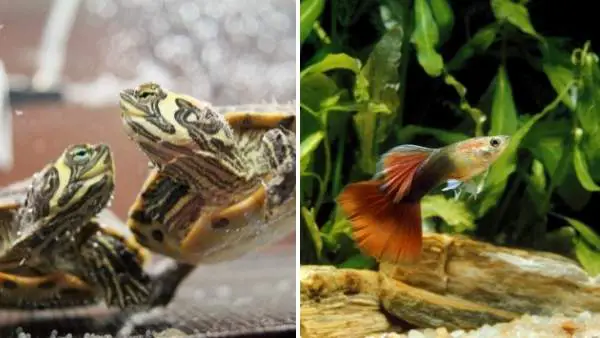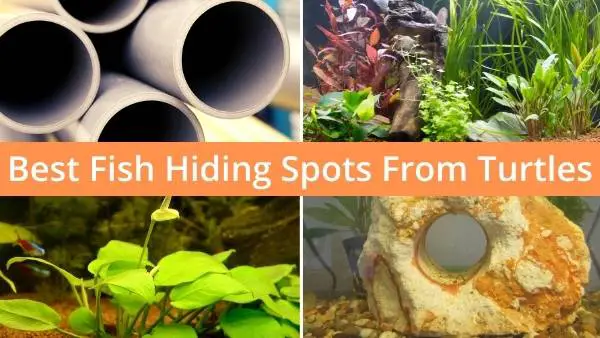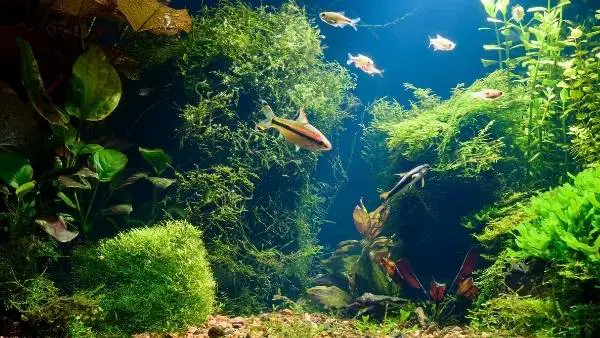Both aquatic turtles and fish are incredibly popular to keep, and of course, they can certainly live together. There are, however, some factors that come into play and certain things you should do to ensure your pet turtles and fish get along well without damaging each other.

The types and species of both fish and turtle (compatibility), tank size, tank and water conditions, and tank filtration all play massive parts in whether or not your pet turtle and pet fish can live together.
Pet turtles and fish can live together in peace and harmony, but only if these requirements are met. For example, a Red-eared slider turtle will probably try and eat small fish, such as guppies or tetras, whereas oscar fish are aggressive and could potentially bite and harm your turtles.
How to Keep Turtles and Fish in the Same Tank
There are some species of turtles that will literally eat any fish that swims in front of them, and there are some that are totally not interested in snacking on fish at all.
There are certain factors that play a huge role in the compatibility of your turtle and fish, and we will be looking at all of them.
Turtle and Fish Species Compatibility
Typically, when you are creating an aquarium community consisting of different fish or marine animals, you should always avoid huge differences in the size of your tank inhabitants.
There are some turtle species that are much bigger and more aggressive than others, and the same applies to fish. So, keep in mind that, if you have an aggressive, large turtle residing with small, placid fish, you will probably not see those fish again!
Which Fish Can You Keep With Turtles?
Unfortunately, there are a lot of turtle species that see fish as food and will go after fish they are put with instantly. On the flip side, there are larger fish species that may also go after some of the smaller turtle species, which indicates why size differences are so important to their compatibility.
You will want to get yourself a fish and turtle pairing that is similar in size and not too large or too small when compared with one another. If you do want to house small fish still, it is recommended to acquire quick and agile fish that can easily escape turtles.
Another recommendation is to provide your fish with plenty of hiding spots to protect them against hungry turtles. Plants, caves, rocks, PVC pipes, and other similar tank decor will be perfect for the job.

The list below details the most compatible fish species with pet turtles. Despite being incredibly popular freshwater fish, you should not keep goldfish with turtles as they are naturally slow movers and will likely become a tasty snack for your turtle.
- Algae eaters
- Corydoras
- Neon tetras
- Cherry barbs
- Zebra danios
- Mollies
Tank Size and Habitat
Creating the perfect habitat for your turtles and fish is of the utmost importance when you are trying to create a compatible partnership. The size is essential in creating space for turtles, fish, and other creatures to reside together.
Also, a powerful water filter is important to keep the water clean. By having a more varied aquarium community, you will be naturally putting more pressure on your water filter.
By choosing a large enough tank for your fish and turtles, installing powerful pumps, using good-quality water filtration, and having multiple filtration systems, you are certainly providing your community the best chance of compatibility.
Typically, many hobbyists will purchase tanks that are too small for fish and turtles, which causes stress and aggression. Not only this but having a tank that is too small will likely cause bacterial build-ups within your tank much quicker than usual which can easily lead to diseases in your community.
Best Fish Tank Sizes for Turtles and Fish
It is so important you pick the correct size tank, even if your tank is seemingly massive compared with its inhabitants, that is far better than having a tank too small for its inhabitants.
Typically, you should have no smaller than a 30-gallon (113 liters) tank for a turtle of up to 6 inches (15 cm) in length (fully grown). For a turtle between 6 and 8 inches (15 cm - 20 cm) in length, you should house them in a 55-gallon tank (250 liters), and the tank size should be between 75 and 125-gallons (340 to 568 liters) if the turtle is over 8 inches (20 cm+) in length.

For the number of fish you should keep in a tank, the general rule of thumb is to have one gallon per one inch of fully-grown fish. An example of this working would be having 20 1.5-inch neon tetras would mean you would have to house them in a fish tank no smaller than 30 gallons (1.5 x 20).
Both fish and turtles need enough room to comfortably swim around, with the water depth being at least twice the length of your turtle. An example would be that red-eared slider turtles need 16 inches of water depth as they are 8 inches in length.
Additionally, turtles do need land too, so, you will have to incorporate a land area within your tank that is above water. It is important to remember that turtles do not breathe in water and do require oxygen in order to survive, so, to avoid your turtle drowning, you should provide them with a substantial amount of land.
Tank Conditions
The tank conditions are as important as anything when it comes to your turtles and fish living together in harmony. Temperature and pH levels will need to be established so that your tank occupants will live a healthy life.
Water Temperature and pH Levels
The majority of tropical fish prefer water being between 72 - 80°F (22 - 27°C), whereas turtles prefer water between 72 - 86°F (22 - 29°C). The pH level should be anywhere between 5.5 and 7.5 for freshwater fish, and the aquatic turtles should be between 7.4 and 7.8.
So, anywhere between 75 and 80°F (25 - 27°C) for both your fish and turtles to live comfortably together is fine. Additionally, the pH levels should be between 7.4 and 7.5 for both to thrive.
Filtration System
You will certainly need a powerful filtration system when housing both fish and turtles as they create an abundance of waste in the tank water.
What Filters Should You Use?
Most people tend to use submersible filters in a small fish tank, however, they usually do not work as well when they are trying to keep up with that of a larger fish tank.

So, the recommended filter to use is a canister filter, which mounts underneath the tank. This is perfect as they will not take up space and room inside of your tank.
Canister filters provide a multi-stage filtration system, typically between three to five stages offering the best filtration for your fish and turtles.
FAQs
Let's dive into some frequently asked questions surrounding this topic.
Can Turtles Live with Crabs and Crustaceans?
No, unfortunately, turtles and crabs cannot be tank mates. In the wild, aquatic turtles tend to eat a balanced diet consisting of algae, seagrass, shrimp, crabs, and other crustaceans.
If you have small inhabitants that are also incredibly slow-moving, such as crabs, they will not last long before being eaten. Equally, if the crab is larger than the turtle, then you may experience the crab attacking and hurting the turtle.
Can Small Turtles Live With Fish?
Turtles that are considered some of the smallest are mud turtles and musk turtles and both are more than compatible with fish. The only consideration is that larger fish may attack or at least pick on the turtles if there is a huge size difference.
By picking smaller fish to accompany your smaller turtles you will likely alleviate this issue. Moreover, you should choose fish that are peaceful by nature.
Can Turtles Live With Frogs?
Both turtles and frogs should certainly not live in the same tank as each other. Whichever is the larger of the two will likely attempt to eat the other one, or at least inflict some harmful damage.
